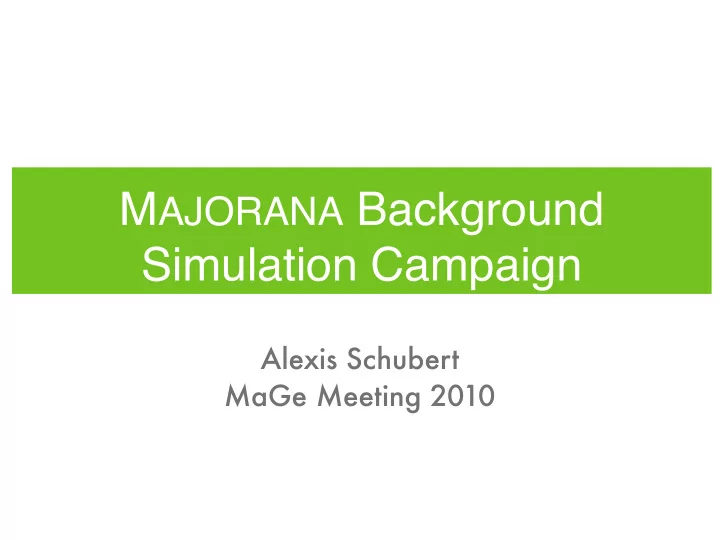

M AJORANA Background Simulation Campaign Alexis Schubert MaGe Meeting 2010
simulation campaign status • Reyco performed previous simulation campaign in 2005 • Preparing for new simulation campaign • Code new geometries • Write new MaGe output class • Run many simulations • Store information in new databases • Create code to process MaGe results into suitable input for background model framework
new geometries • D EMONSTRATOR geometry • Reyco will start soon • BEGe geometry • no dead layer; handled in analysis • first draft completed, not in SVN
new MaGe output class • MGDO MJMCRun • creates ROOT file containing TTree of MGDO MGMCEvent objects • alternative to G4Steps • code to analyze MaGe results will not need to compile against MaGe • in development
planned simulations Signal and Background sources A preliminary list of sources of backgrounds and signals for the simulation campaign, compiled from Background Summary Document tables and recommendations Source Notes Highest priority simulations 0 ��� dark matter U, Th, K in Cu consider effects of cracks in shielding U, Th, K in Pb shielding consider effects of cracks in shielding U, Th, K in Ge U, Th, K from experimental hall U, Th, K in electronics, cables surface � s on detectors (and � s) Bela (from GERDA) says to see Eberth and Simpson (Prog. Part. and Nucl. Phys. 60(2008)283 Review) 40 K in electronics tritium in Ge 2 ��� of 76 Ge 68 Ge 60 Co in Ge 60 Co in Cu 207 Bi in Cu radon in air spaces/plate out and others
simulation of U, Th chains • Split simulation of 238 U chain: ◦ 238U->234Th ◦ 234Th->234U simulate each step separately ◦ 234U->230Th to allow studies of ◦ 230Th->226Ra ◦ 226Ra->222Rn disequilibrium in decay chains ◦ 222Rn->210Pb ◦ 210Pb->210Bi or 206Pb via 206Hg ◦ 210Bi->210Po or 206Pb via 206Tl ◦ 210Po->206Pb • Split simulation of 232 Th chain: ◦ 232Th->228Ra ◦ 228Ra->228Th or 224Ra via 224Fr ◦ 228Th->224Ra ◦ 224Ra->208Pb
planned databases • runs database • script to start a MaGe run will create a database entry • number of events, isotope, output file location, ... • material purity database • geometry information about detectors and other components
analysis chain Background model contribution MaGe MCRun Pulse-shape remove steps ROOT output: ROOT output: analysis, in inactive Crystal hits in each data from single-site time volumes and event in each every step in correlation analysis, dead layers detector each event granularity cuts PDF for fits
future work • code D EMONSTRATOR geometry • finalize MCRun output class • simulate backgrounds from list • create databases: runs (started), material purity, components • complete and verify post-processing code
supplemental slides
MaGe MCRun ROOT output MJAnalysisStepData • TTree of MGDO MGTMCEvents remove steps in dead layer • created from MaGe • MGTMCEvent • AddDeadLayerInZ( z1, z2) step output • int fEventID; • AddDeadLayerInRandZ( r1, z1, r2, z2) • not saved to file, just an • std::string fRandGenState; • Transform( MJAnalysisStepsData) intermediate object in • double fTotalSensitiveEdep; • dead layers may vary between processing loop • int fNSteps; detectors and detectors will have remove steps in • contains array of steps • TClonesArray* fSteps; varying geometries -- I didn ʼ t consider inactive volumes • x • MGTMCStepData this • in constructor of • y • bool fIsPreStep; • to handle variations in detectors: new class • x • int fParticleID; • should have one class instance per • t • int fTrackID; detector ID? • E • int fParentTrackID; • specify a detector ID for each dead • detectorID • double fX; layer added? • double fY; • double fZ; • double fT; • double fLocalX; • double fLocalY; MJAnalysisPsaFlag • double fLocalZ MJAnalysisEvent • dT heuristic • double fEdep; • constructor takes • operate on MJAnalysisStepsData • double fPx; MJAnalysisStepData • set MJAnalysisEvent psaFlag • double fPy; object according to result • double fPz; • contains info for each • std::string end result: detector fProcessName; MJAnalysisEvent • E • std::string • detectorID fPhysVolName; MJAnalysisSstcFlag • psaFlag • int fSensVolID • operate on vector of • sstcFlag MJAnalysisEvents • time • set MJAnalysisEvent sstcFlag for relevant events
Recommend
More recommend